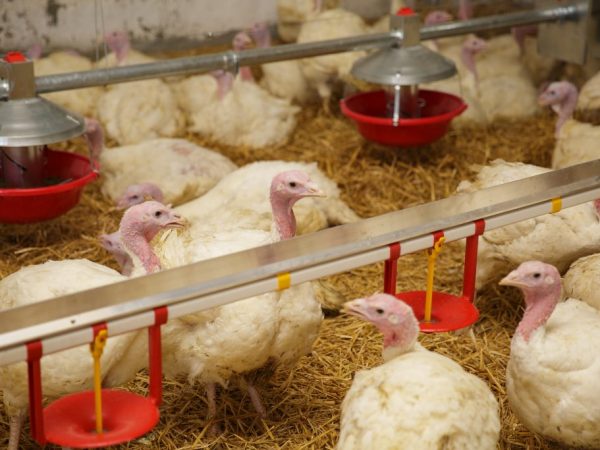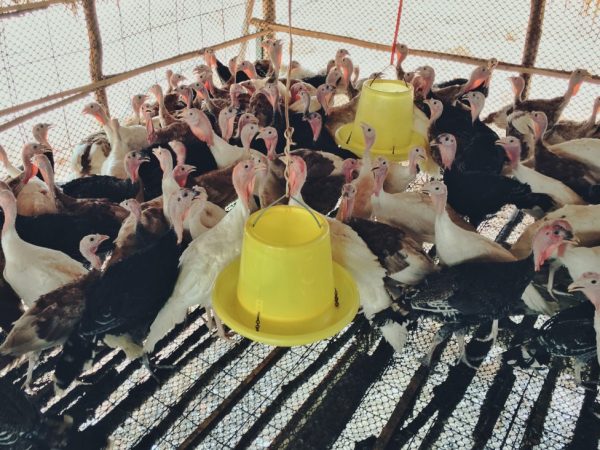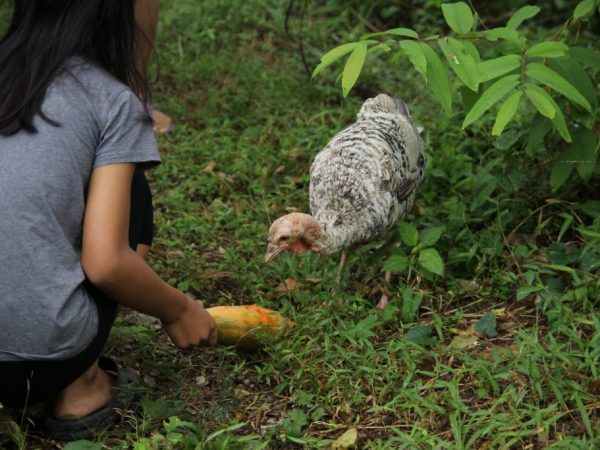How to feed turkey poults in the first days of life and subsequent months
The most important part of caring for turkey poults is feeding. By 6 months, almost all broiler breeds have stopped gaining weight. Therefore, it is very important to feed chicks correctly from the first days of life. Consider what to feed the turkey poults in the first days of life, and how to change the diet as they grow older.

Feeding turkeys in the first days of life and subsequent months
Feeding features
A turkey is a rather capricious bird. If the food is organized incorrectly, the birds will not gain even average weight, let alone the maximum. In no case should you give to birds compound feed Low quality.
Wet mash after feeding should not be left in feeders... Sour food causes problems in the digestive tract. And in turkeys, due to the anatomical structure, food in the intestines lingers longer than in other birds. And if in chickens, for example, dirty or sour food quickly leaves the intestines and, possibly, does not harm the body, then turkey poults will certainly have problems with the gastrointestinal tract.
Feeding turkeys in the first month of life does not imply a high amount of fiber in the diet. This will lead to a blockage in the intestines, the consequences of which can be the most dire.
Feeding turkeys in the first 10 days of life
Newborn chicks are the hardest to care for. Immediately after the turkey is born, do not rush to feed it. During the first day, he can spend those food reserves that he still has. But do not forget to put a container with water. At the same time, it is not necessary to water the chicks; it is enough to show them where the drinking bowl is. In order for birds to form a strong immunity, we add vitamin C to the water. turkey drank such a drink with pleasure, sweeten it.
During the first 10 days, we feed the turkeys at least 8 times a day. During this period of life, turkey poults are poorly seen. Accordingly, containers with water should be in a conspicuous place.
Newborn diet
- Starting from the first days of life, turkey poults are given a dry mash, which consists of boiled eggs, corn and wheat grits. Oatmeal is an alternative to wheat grits. We put the same amount of eggs and corn, and cereals should make up only a quarter of the weight of a serving. But after 3-4 days, we increase the amount of cereals. And by the 6th day, all ingredients are taken in equal quantities.
- Cottage cheese. We choose high quality low-fat cottage cheese. It should be crumbly.
- Millet. We add it to dry mash in small quantities.
- Finely chopped carrots. As they grow older, carrots can be given chopped.
- Sour milk. But it cannot be added to the mash. During the first week of life, we pour it into a separate container and place it next to the drinker. At the end of feeding, remove the container with yogurt so that it does not sour.
- A piece of chalk.It is a mineral supplement that is essential for building strong bones. Bone, fish and meat-and-bone meal is an alternative to chalk. It is advisable to include all 3 supplements in the diet, but give them not together, but in turn. You can add these mineral supplements to the mash, but experts recommend pouring them into separate containers and leaving them in the house throughout the day.
- Fish oil (no more than 2 grams per day).
- Salt (add to the mash). The daily norm is 0.1 g.
- Water.
In the diet of birds, solid food must be present. This is necessary to stimulate the work of the digestive tract, which is poorly developed after birth. From the 3rd day, you can introduce wet mash into the diet, for the preparation of which we use only the above products. the composition of the wet mash can be as follows: cottage cheese, hard-boiled eggs, wheat bran, wheat flour, corn, chalk. Corn with wheat flour should make up 50% of the weight of the entire serving. We add chalk no more than 2 g. The rest of the ingredients are taken in equal amounts.
Newborn turkeys have a soft beak. So that the chicks do not get injured, they are fed from containers with a soft bottom. Silicone feeders are the most suitable option. Thick paper or soft fabric is an alternative.
Feeding turkey poults from day 10 to day 30

Needles can be added to the diet of monthly chicks
Starting from the 10th day of life, we gradually reduce the number of meals from 8-9 to 6. At this age, we add wet mash to the diet. We cook them in yogurt or milk of medium fat content. In addition to those feeds that were used during the first 10 days of life, we add oats, legumes and buckwheat, meal, cake, green feed, pine needles, straw and hay, nuts and acorns to the diet.
Each of the above components is important for the normal development of birds. Green food contains carbohydrates, and hay and straw contain fiber, which improves the digestion process. Needles are rich in vitamin C, while nuts and acorns improve taste of meat... Feeding turkey poults at the age of 1 month includes fish and meat and bone meal. These foods are not only rich in vitamin C but also contain amino acids. They also contain protein, which is essential for many processes in the body.
As for quantitative indicators, during this period we slightly increase the amount of wheat and barley groats. But we increase the amount of green fodder by 6 times. The daily norm is 30 g. We remove millet and boiled eggs from the diet.
Feeding turkeys after day 30
Feeding turkey poults from 1 month changes somewhat. At this stage, the diet should be rich in protein. It is important not only how to feed the turkeys in 1 month, but also how many times. We transfer grown chicks to 4 meals a day. If turkeys have a sedentary lifestyle, then feed them 3 times a day. A sedentary lifestyle may be due to the lack of an enclosure of the required size or the characteristics of the breed. In general, turkeys should be grazed. Otherwise, they may face such a problem as obesity.
So, how to feed your monthly turkey poults at home? Mushrooms form the basis of the diet at this age. But, we cook them not with yogurt, but with water. At this age, curdled milk and return are completely excluded from the diet. When preparing mash, we use a large amount of green fodder. The last meal consists of grains.
If we talk about the daily rate of certain feeds, then the amount of fresh greens in the diet is doubled. We introduce crushed oat and wheat grains into the diet (10 g for each individual), increase the amount of barley groats to 21 g. We also add wheat bran to the diet. Their daily rate is 20 g. We remove cottage cheese from the diet.
Feeding turkeys from 1 month old is simplified in the summer, which is rich in green feed. It is advisable to release birds to pastures, where they themselves will find grass that will suit their taste.
In order not to puzzle over what to feed the turkey poults after 1 month in the winter months, we harvest a large amount of hay and straw.
Feeding turkeys after 3 months
The composition of turkey feed does not change qualitatively at 3 months of age. Only the daily feed rate changes. So, how to feed turkeys at 3 months.
Meat and bone meal and wheat bran should be 20 g for each turkey. We give crushed wheat grain at the rate of 50 g per individual. The rate of green forage is increased 2.5 times, and is 150 g for each turkey. We give salt and chalk at the rate of 5 g for each individual.
When compiling a diet, you should not dramatically increase or decrease the amount of one or another component. So, for example, we increase the amount of green fodder every week by 20-30 g. The figures given by months are control. We organize meals in such a way as to simply reach these numbers by the end of each period.
Compound feed

Compound feed will provide balanced nutrition
Organizing food is not an easy task. In order not to think about what to feed the turkey poults at 1 month, or at 3 or 5, you can purchase ready-made feed. There is a wide range of these products on the market. When purchasing compound feed, carefully study its composition and manufacturer's recommendations. Some formulations are intended for feeding monthly turkeys, others are used for feeding newborn chicks.
Using compound feed is much easier to organize a balanced diet. The birds eat purchased products with pleasure. But in addition to compound feeds, no matter how good quality they are, turkeys need to be given complementary foods in the form of mineral supplements (chalk and shell crushed to a powder state).
It is important not only what to feed the turkey poults with in the first days of life, but also how much feed to give. Do not overfeed birds. The instructions, which are attached to all compound feeds, indicate the daily rate for turkeys of different ages. So, for example, monthly turkeys need, on average, 150 grams of food per day. But adults should eat 350 grams of feed. Turkeys need 50-100 g less feed.
DIY compound feed
If you wish, you can make compound feed at home. The basis of any compound feed is made up of wheat, corn and oatmeal, sunflower cake, low-fat cottage cheese and bone meal. We use cleaned wood. This compound feed is suitable for feeding weekly chicks. Adding greens to this composition, we get compound feed for turkey poults that have reached ten days of age. But you should only choose young greens. Nettle and cabbage leaves are best suited.
When preparing compound feed at home, you need to know how much each component should be in the composition. Since the weight of the daily rate changes as the birds grow older, we will consider the percentage of the main ingredients used to prepare the compound feed.
Corn grits and soybean meal, which should be the most in the composition, account for 60%. These components are taken in equal amounts. About 10% is accounted for by sunflower cake. Wheat accounts for about 8%, chalk and bone meal 5% each and ½% salt. If in the composition, in addition to sunflower meal, there is soybean meal, then they are taken in approximately equal quantities. There should be 3-5% more sunflower meal.
For matured individuals, the composition of the compound feed can be as follows: 40% corn grits, 30% - sunflower and soybean meal, 10% meat and bone meal, 5% feed yeast and dry skimmed milk each, 2% limestone and grass meal, 1% feed fat and 0 , 5% seashells.
The diet varies somewhat depending on the breed of turkeys. When buying turkey poults or hatching eggs, ask the breeder about the breed.
What to feed turkeys with
We figured out how to feed turkeys from the first month of life. But there are also products that are banned.It is forbidden to give fiber to turkeys in the first 10 days of life. It can not only cause problems with the digestive tract, but also cause the death of the livestock. All mixtures for young animals need to be made from quality food. Newborn chicks are not resistant to various diseases. Especially watch out for the quality of animal products (eggs, reverse, cottage cheese, yogurt).
Prepare wet mash just before feeding. When preparing wet mash at home, make sure that the porridge is not too wet. It should remain crumbly. Wet food is difficult for birds to digest. All grain crops are given to young growth in crushed form. So they are better absorbed.
Turkeys do not respond well to dietary changes. If you are replacing your home-made mash with factory feed, do it gradually. Even if we are talking about changing one compound feed for another, make the transition smooth.
Conclusion
We examined how you can feed monthly turkey poults and newborn chicks. The easiest way is to organize a balanced diet using factory feed. You can make an analogue at home. But, for feeding newborn chicks, experts recommend using factory feed. The most popular are starting compound feeds PK-1 and purine 10050. The first compound feed contains mineral supplements, vitamins and amino acids.


